Band Placement
Excel Orthodontics is continually seeking ways to save time, improve efficiencies and increase the quality of patient care. Our lab services and appliances help make it possible to accomplish evaluation of our laboratory processes there are several factors to consider:
ACCURACY OF MODELS – A FUNCTION OF IMPRESSION TAKING AND MODEL POURING.
Several designs fabricated at Excel use bands on molars, including RPE’S, Pendulums and Herbst appliances. As doctors know, seating of these types of fixed appliances can be challenging if there is even the slightest discrepancy of the model versus the teeth. This is predominantly seen when there are bi-cuspid bands included in the RX as well. The traditional method used to construct fixed appliances is to select and size the bands in the mouth and take an impression over the seated bands; then remove the bands from the patients teeth and seat back into the bites of the alginate impression, where they are secured using wax or pins. Pouring the impression with orthodontic stone then captures the bands into ideal position, resulting in a working model ready to send to the lab. While many practices use this technique successfully, it can be an issue if the bands become unpositioned.
In a percentage of peer orthodontic labs, cases were found to have discrepancies in the accuracy of the bands in the final model. The most common problem seen is bands that have moved typically. (the result of under-seating them in the alginate prior to pouring.)
Awareness of this most common issue can prevent major disruptions for all involved; the doctor, patient, and laboratory. A slight misalignment of the bands in the model can cause an ill- fitting appliance. Band and model accuracy discrepancies leave our lab technicians often “guessing” which can result in a wasted appointment and/or unacceptable appliance. Not to mention time to recall a patient for the entire procedure to be redone.
As is common with techniques in this field, there is more than one way to accomplish the goal.
BANDS SECURED WITH WAX:
PROS:
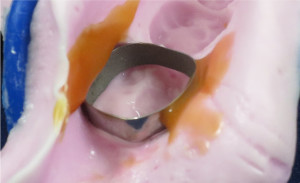 This technique is the most widely used and accepted by the assistants. Hot, sticky wax is dripped over the bands seated in the alginate, which then captures and holds them during the pouring of the stone.
This technique is the most widely used and accepted by the assistants. Hot, sticky wax is dripped over the bands seated in the alginate, which then captures and holds them during the pouring of the stone.
CONS:
 The main problem found is that the wax does not really adhere well to the alginate. Without good adhesion, any slight over-vibratio during the pouring process will allow the band to move out of position. Unfortunately, most of the time not being noticed until the stone has dried.
The main problem found is that the wax does not really adhere well to the alginate. Without good adhesion, any slight over-vibratio during the pouring process will allow the band to move out of position. Unfortunately, most of the time not being noticed until the stone has dried.
PINNING BANDS WITH WIRES:
PROS:
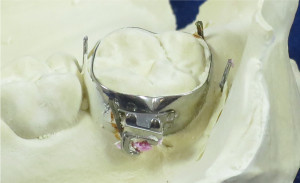 This also is an excellent technique for securing bands in an impression. Small sections of wire (staples work well) are inserted into the alginate just over the exposed edges of the bands. Make sure to use 2 wires per band and secure them (tweezers work) over the mesial and distal third of the bands so they can’t rotate.
This also is an excellent technique for securing bands in an impression. Small sections of wire (staples work well) are inserted into the alginate just over the exposed edges of the bands. Make sure to use 2 wires per band and secure them (tweezers work) over the mesial and distal third of the bands so they can’t rotate.
CONS:
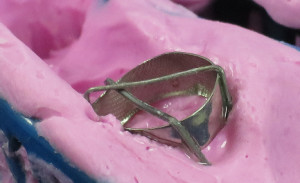 When the bands are not completely secured with the wires, the bands move during the pouring process, causing an inaccurate working model.
When the bands are not completely secured with the wires, the bands move during the pouring process, causing an inaccurate working model.
SUPER GLUE TECHNIQUE:
PROS:
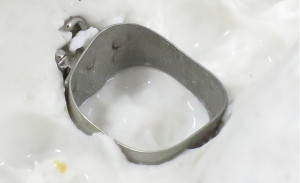 Super glue works well as it adheres to the bands and not the alginate. Using a couple drops ONLY of glue on the inside and outside of each band holds it in place.
Super glue works well as it adheres to the bands and not the alginate. Using a couple drops ONLY of glue on the inside and outside of each band holds it in place.
CONS:
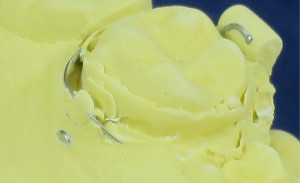 When too much glue is used and if not cleaned from the working model, the excess glue can contaminate the solder joint area as the metal is heated.
When too much glue is used and if not cleaned from the working model, the excess glue can contaminate the solder joint area as the metal is heated.
EXCEL ORTHODONTICS OPTIONS TO FIT AND SEAT BANDS
Excel Seats Doctor’s Bands: Excel offers two lab services that helps avoid many of the troubles associated with bands moving in the impressions. These alternatives do not require the practice to pour an impression holding bands.
OPTION 1:
PROS:
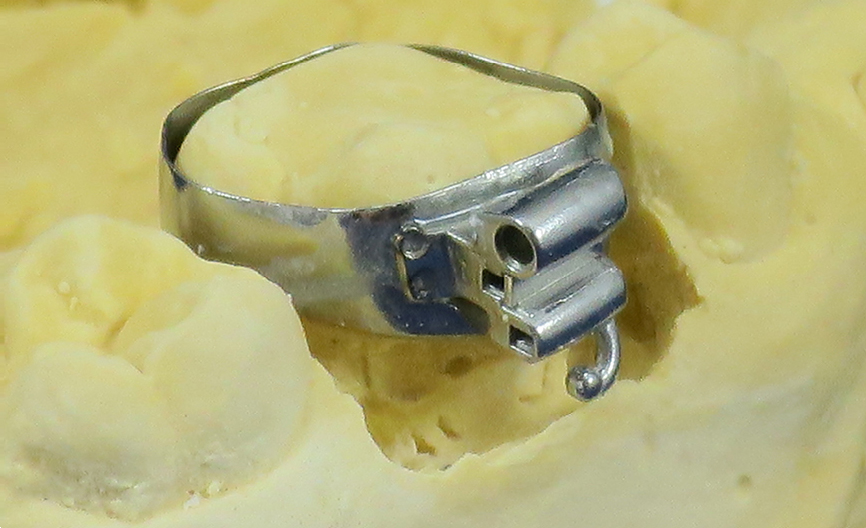 Bands are sized and seated in the mouth to assure accuracy. Then, the bands are removed prior to taking a traditional impression. Lastly, we relieve the model in the appropriate areas, and your bands are reseated accordingly.
Bands are sized and seated in the mouth to assure accuracy. Then, the bands are removed prior to taking a traditional impression. Lastly, we relieve the model in the appropriate areas, and your bands are reseated accordingly.
Excel Provides and Fit Bands: The other alternative that is well-accepted among our doctors and staff is a complete indirect band sizing and fitting procedure in our lab.
OPTION 2:
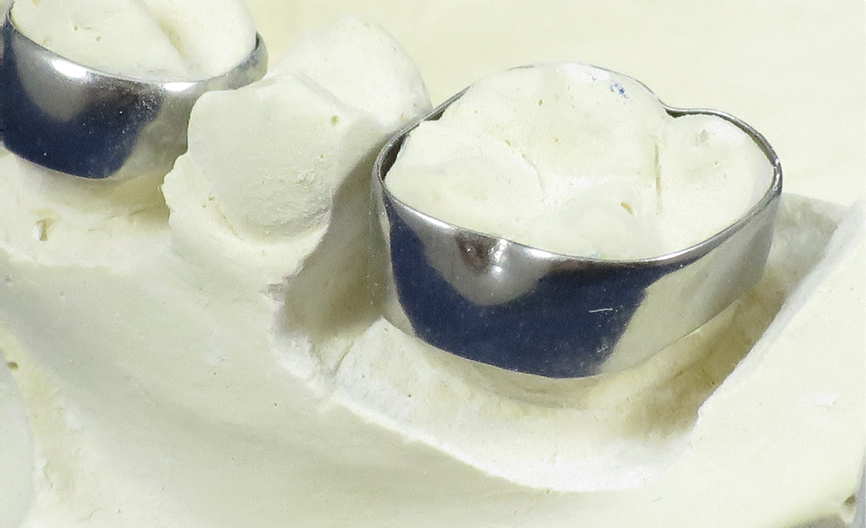 The model is prepared and we select and fit the proper sized bands. The standard band we supply is slightly thicker than conventional orthodontic bands, which also has the advantage of a stronger finished appliance. Another advantage with this method is the saving of the separation appointment because the model sent to the lab does not require band space. The spacers are placed after the impression is taken and the band space is gained while our technicians construct your appliance.
The model is prepared and we select and fit the proper sized bands. The standard band we supply is slightly thicker than conventional orthodontic bands, which also has the advantage of a stronger finished appliance. Another advantage with this method is the saving of the separation appointment because the model sent to the lab does not require band space. The spacers are placed after the impression is taken and the band space is gained while our technicians construct your appliance.
Between your practice and our lab:
Our primary goals at Excel is to produce appliances that can be seated in a timely manner with a minimal amount of adjustments. Using our educational suggestions and techniques are to help ensure we construct accurate appliances. Please feel free to contact Excel Orthodontics if you have any further questions regarding our services.
971 249-0261 or excel@excelorthodontics.com.

